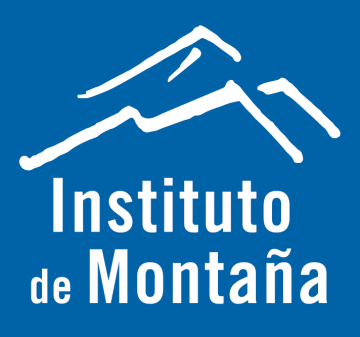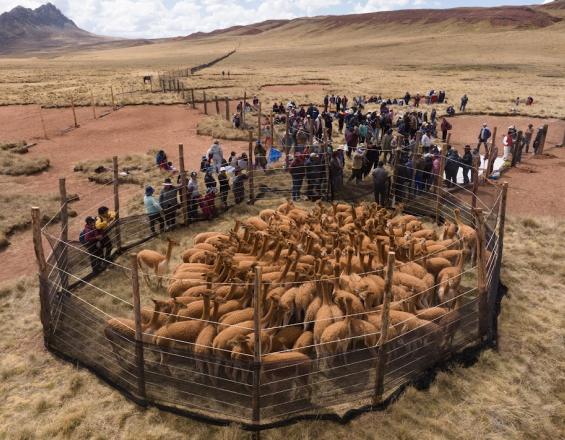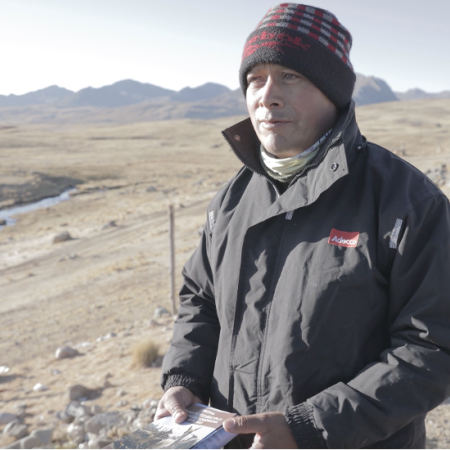
Sustainable communal management of native grasslands and vicuñas in the Tomas Campesino Community, Peru

The community of Tomas and the Mountain Institute implemented an Ecosystem-based Adaptation (EbA) measure in partnership with the Nor Yauyos-Cochas Landscape Reserve and IUCN. Our adaptation solution combined local and scientific knowledge and had four components: (1) Strengthening community organization, (2) Strengthening local capacities and knowledge, (3) Green-gray infrastructure, and (4) Livelihoods.
The AbE measure in Tomas responds to a community priority: improving management of the vicuña, a South American camelid whose fiber is highly valued and which is better adapted than exotic livestock to current and future climatic conditions in the area. The community has fenced off 241 hectares of native pastureland that it will manage sustainably for raising vicuñas. Thus, the AbE measure contributes to improving local livelihoods and increasing the resilience of the population and ecosystems to climate change.
Context
Challenges addressed
Main challenges in the Tomas community:
- Extreme weather events, such as frost and drought, negatively affect pasture availability and quality.
- Water shortages due to decreased rainfall.
- Labor shortages and abandonment of ranches due to migration.
- The Covid-19 pandemic paused the work of the community and the Vicuña Committee, reducing motivation.
- Clashes between power groups.
- Working with vicuñas brings economic benefits; however, it is necessary to strengthen local capacities in various areas (health, fiber processing, marketing, etc.), which is a long process that requires time, knowledge and dedication.
Location
Process
Summary of the process
The strengthening of the institutional framework and community organization, together with the strengthening of local capacities and knowledge, have made it possible to improve the green-gray infrastructure. This infrastructure consists of 241 fenced hectares of native grasslands that are sustainably managed for raising vicuñas. Well-managed grasslands improve their capacity to provide forage and water regulation and provide suitable habitat for vicuñas, contributing to improving local livelihoods and increasing the resilience of people and ecosystems to climate change.
Building Blocks
Strengthening of institutional and community organization
The "Strengthening institutional and community organization" component included numerous work sessions, workshops and planning activities with local authorities, including coordination with organizations in charge of vicuña management, such as the Regional Directorate of Agriculture, the National Agrarian Health Service, the National Forestry and Wildlife Service and the National Service of Natural Areas Protected by the State.
The objective was to strengthen community organization in collective decision making for the management of their natural resources and thus contribute to improving their livelihoods and resilience in the face of climate change.
Overall, these activities have contributed to improving the community's capacity to manage vicuñas and their native grasslands. One example of their improved management capacity is that the community was able to reactivate the Vicuña Committee and develop its work plan. In addition, thanks to the commitment of the community members and the leadership of the vicuña committee, it was possible to expand the fence and build the chaku with the help of community labor, with the support of the team from the Nor Yauyos Cochas Landscape Reserve and the Mountain Institute.
Enabling factors
- Common interests among the parties: authorities, community members, RPNYC, project team.
- The 2018-2020 community board of directors committed and assumed leadership.
- The community's interest in vicuña breeding and their initiative to form a working group to lead the sustainable management of these animals.
- Support and commitment from park rangers and RPNYC authorities.
- Commitment from community members.
- Ongoing support through a Mountain Institute facilitator trained in participatory approaches and methods.
Lesson learned
- Working on community empowerment and organization is a time-consuming process that is fundamental to achieving long-term results.
- It is key that the field team is trained in the application of participatory approaches, methods and tools and the facilitation of collective learning.
- The people that make up the vicuña committee must have time, commitment, willingness, curiosity and responsibility.
- Procedures to obtain permits for chaku, shearing and sale of fiber take time due to the number of institutions involved. The requirements and timeframes of each institution should be taken into account so as not to delay the process.
- It is advisable to identify from the beginning the people interested in assuming leadership positions, both women and men.
- It is important to keep the Vicuña Committee informed of training events that may occur.
- It is important to work on gender issues, given that women's role in post-shearing fiber management is essential.
Strengthening of local capacities and knowledge
As part of this component, a participatory diagnosis of the Tomas Community was carried out, using participatory tools in workshops and field visits, which integrated local knowledge with that of external researchers in agrostology, hydrology, archeology and social sciences. After evaluating several possibilities, the diagnosis culminated in the selection and design of the EbA measure, prioritizing work with vicuñas, which the community had begun to work with on a small scale in the 2000s. These activities contributed to the consolidation of the Community Board of Directors and the Vicuña Committee, a 6-member organization that is part of the Tomas Community and is in charge of organizing all activities related to the management of the vicuñas that the community raises in semi-captivity.
The project team provided training on sustainable management of vicuñas, pastures and water, as well as procedures for organizing the Chaku (ancestral technique for capturing and shearing vicuñas), disease management and sanitary treatment. Training was also provided on the vicuña law and the procedures and legal requirements for selling vicuña fiber, due to its status as a nationally protected species.
Enabling factors
- Willingness and commitment of the members of the Vicuña Committee.
- Local knowledge of vicuña management.
- Good participatory work plan, validated in community assembly.
- Exchange of knowledge among communities.
- Permanent support from the team of facilitators and external researchers.
Lesson learned
- In order to prepare the diagnosis, it is essential to incorporate local perspectives and knowledge from the diagnosis and throughout the training process.
- Promote spaces for capacity building and exchange in the field, and limit classroom workshops, since the community members are not used to these dynamics.
- It is positive to have spaces for reflection to review and adjust the work plan.
- Weak coordination between entities involved in vicuña management may hinder the progress of the measure.
Improvement of green-gray infrastructure
The AbE measure implemented in Tomas includes both green and gray infrastructure. The green infrastructure, which is the ecosystems, is improved by promoting appropriate pasture and vicuña management practices and expanding the sustainably managed area. As for the gray infrastructure, it is the fence itself.
Thus, the improvement of green-gray infrastructure consisted of expanding the fenced area for vicuña management in communal pastures (from 38 to 241 hectares). The process to carry it out began with the diagnosis and design of the AbE measure, which was validated in a community assembly. Subsequently, the area to be fenced was mapped out, the holes were dug and the wooden posts were planted. Finally, the entire fence was painted.
All these actions were carried out through community work, under the leadership of the vicuña committee.
Once the fence was completed and the documentation was in order, the vicuñas were captured and sheared(chaku). At the initiative of the community, the preparation of the chaku included making an offering to the mountain to "ask for permission and a good omen".
More than 200 people participated in the chaku: children, youth, women and men from the community and some outsiders.
Enabling factors
- High value of vicuña fiber, demand for the product and existence of markets.
- Ancient practice of chaku and traditional knowledge.
- Commitment from authorities, the Vicuña Committee and all community members.
- The vicuña is a species very well adapted to the conditions of the high Andes and resistant to many of the effects associated with climate variability and change.
- The community has territory that is conducive to the development of this species.
- Need to expand the vicuña enclosure because they were already suffering stress due to insufficient space.
Lesson learned
- Participatory design of the AbE measure is key to its success.
- Documenting the capture and shearing process helps to improve the treatment of the fiber and serves as experience for future chakus.
- Maintaining the fence in good condition and replacing deteriorated posts and mesh is necessary to prevent vicuñas from escaping.
- It is recommended that the community organize to control and monitor their vicuñas to avoid loss or theft.
- It is necessary to improve the organization of the chaku, shearing and processing of the fiber, delegating and better organizing the functions within the Vicuña Committee to optimize the quality of the product obtained and reduce losses.
Impacts
The expansion of the vicuña management area will contribute to the recovery of pastures and wetlands in the area and, in turn, improve soil moisture and infiltration capacity, thus increasing the resilience of the population and ecosystems to droughts, frosts and increased climate variability.
In addition, the EbA measure has helped strengthen community organization and linkages with government institutions and other entities. The capacities and organization of the vicuña committee were improved in water management, management of the species, and regulatory and sanitary issues. For example, the Vicuña Management Declaration (DEMA) in semi-captivity was updated, which is a requirement for obtaining a shearing and fiber marketing permit. This favors the sustainable management of vicuñas and long-term production of fiber.
The expansion of the vicuña perimeter fence will allow the animals to develop in better conditions, reducing their stress.
After five years of not being able to shear the vicuña due to lack of permits and internal conflicts, the Tomas community held its "First Vicuña Chaku Festival". Chaku is an ancestral technique for capturing and shearing vicuñas. In Tomas, 16,962 kg of fiber were obtained for sale. With a price close to US$280/kilo, this will help improve the community's income.
Beneficiaries
- Direct: 111 families (approximately 500 people) in the community of Tomas.
- Indirect: Irrigators from the middle and lower part of the Mantaro basin.
Sustainable Development Goals
Story

Testimony of José Ruiz, member of the Tomas vicuña Committee and RPNYC park ranger.
"In the 2000s, the Tomas community decided to harvest vicuña fiber in chakus in silvestry. For 2 or 3 years, they had favorable chakus, as well as failures due to lack of experience. Vicuñas in the wild are very difficult to capture and, although we have brought specialists from other communities, we have failed. During all this time, we have realized that it is a matter of community organization. We have to be well organized, obedient, compliant and know how to listen in order to be able to do this work. If someone wants to do something he wants and does not listen to the monitors who lead the capture, it is a failure.
Then, around 2012, another chaku was carried out in a small fence of 30 hectares of land; we had approximately 70 vicuñas. There we have had the capture and shearing, the use of the vicuña fiber.
Later, thanks to the fact that the community is located within the Nor Yauyos Cochas Landscape Reserve, the EbA Montaña project arrived and with them we began to work on the implementation of fences for the recovery of pastures. This was because the effects of climate change were being felt at this altitude, the water could no longer support us throughout the year, it was no longer like before. In this way, the community members of Tomas have been recovering the pastures and also helping to feed the cattle.
The Escalando AbE project works directly with the vicuña. With this support, the fence was extended to 240 hectares. They have also supported us in formalization, because in order to harvest the fiber, we not only have to go, capture, shear and sell, but we also have to coordinate with the institutions in charge of management, such as the Regional Directorate of Agriculture, the National Agrarian Health Service, the National Forestry and Wildlife Service and the National Service of Natural Areas Protected by the State, with its team of park rangers.
Today we are about to start the chaku and we are very confident that we are going to be successful. At present we have approximately 150 vicuñas; we have increased the number of vicuñas considerably. We already have the experience and the organization.
Going forward, the community is looking at vicuña management as one of our priorities. Incidentally, it helps us to manage and maintain our healthy ecosystems".














